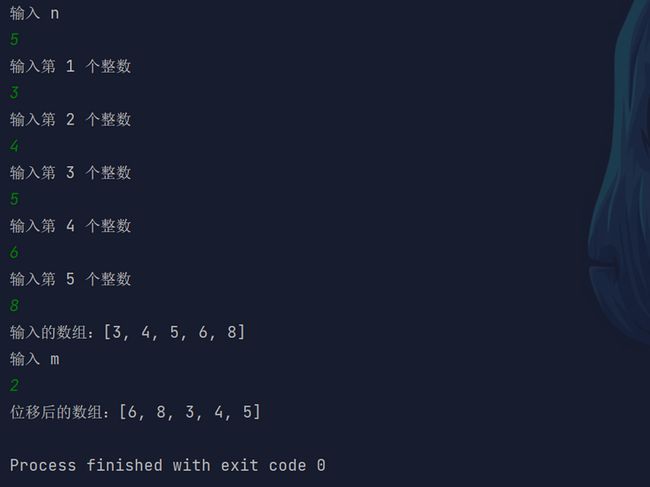本文已同步至:村雨遥
实例 36
题目
有 N 个整数,使其前面各数顺序向后移 M 个位置,最后 M 个数变成最前面的 M个数。
分析
首先是设置输入,输入数组及相关参数值之后,将原数组复制到新数组中,然后通过计算新位置和原来位置的关系 index = (i + m) % n,将原数组中的元素进行位置交换。
实现
import java.util.Arrays;
import java.util.Scanner;
/**
* Created with IntelliJ IDEA.
*
* @author : cunyu
* @version : 1.0
* @email : [email protected]
* @website : https://cunyu1943.github.io
* @date : 2021/6/4 14:34
* @project : Java 编程实例
* @package : PACKAGE_NAME
* @className : Example36
* @description :
*/
public class Example36 {
public static void main(String[] args) {
Scanner scanner = new Scanner(System.in);
System.out.println("输入 n");
int n = scanner.nextInt();
int[] arr = new int[n];
for (int i = 0; i < n; i++) {
System.out.println("输入第 " + (i + 1) + " 个整数");
arr[i] = scanner.nextInt();
}
System.out.println("输入的数组:" + Arrays.toString(arr));
System.out.println("输入 m");
int m = scanner.nextInt();
int[] newArray = new int[n];
// 定义一个新的数组,与原来的数组长度相同
for (int i = 0; i < n; i++) {
newArray[i] = arr[i];
}
// 计算新的位置
for (int i = 0; i < n; i++) {
int tmp = (i + m) % n;
arr[tmp] = newArray[i];
}
System.out.println("位移后的数组:" + Arrays.toString(arr));
}
}
结果
实例 37
题目
有 N 个人围成一圈,顺序排号。从第一个人开始报数(从 1 报到 3),凡是报到 3 的人则退出圈子,问最后留下的是原来第几号的人?
分析
著名的约瑟夫环问题,用数组求解的基本思想就是用一个一维数组去标识这 n 个人的状态,默认全为 true ,也就是都在圈子内,当数到 m 的人出圈之后,标识置为 false(就是出圈了),同时报数器清 0,下一个人要从 1 开始。在每次报数之前要判断他是否在圈子内(也就是他的标识是否为 true ),如果在圈子里面才会继续报数。定义一个变量记录出圈的人数, 出圈的人数等于 n-1 时,则游戏结束。
实现
import java.util.Scanner;
/**
* Created with IntelliJ IDEA.
*
* @author : cunyu
* @version : 1.0
* @email : [email protected]
* @website : https://cunyu1943.github.io
* @date : 2021/6/4 15:00
* @project : Java 编程实例
* @package : PACKAGE_NAME
* @className : Example37
* @description :
*/
public class Example37 {
public static void main(String[] args) {
// 输入围成圈的人数
Scanner scanner = new Scanner(System.in);
System.out.println("输入围成圈的人数");
int num = scanner.nextInt();
// 设置对应人的标志
boolean[] arr = new boolean[num];
for (int i = 0; i < arr.length; i++) {
arr[i] = true;
}
// 计数
int left = num;
// 报号
int counter = 0;
// 对应围成圈的人在标志数组中的索引
int index = 0;
while (left > 1) {
// 一旦数到 3 的人,标志位置为 false,表示出局
if (arr[index] == true) {
counter++;
if (counter == 3) {
counter = 0;
arr[index] = false;
left--;
}
}
index++;
if (index == num) {
index = 0;
}
}
// 最后标志数组中为 true 的人,则代表最后留下来的人
for (int i = 0; i < num; i++) {
if (arr[i] == true) {
System.out.println("原来排在第 " + (i + 1) + " 位的人留下了!");
}
}
}
}结果
实例 38
题目
写一个函数,求一个字符串的长度,在 main 函数中输入字符串,并输出其长度。
分析
求一个字符串的长度,只需要调用 length() 方法即可,但是这里应该是不允许使用该方式,所以我们换用一种方式。
实现
import java.util.Scanner;
/**
* Created with IntelliJ IDEA.
*
* @author : cunyu
* @version : 1.0
* @email : [email protected]
* @website : https://cunyu1943.github.io
* @date : 2021/6/4 15:16
* @project : Java 编程实例
* @package : PACKAGE_NAME
* @className : Example38
* @description :
*/
public class Example38 {
public static void main(String[] args) {
Scanner scanner = new Scanner(System.in);
System.out.println("输入一个字符串:");
String str = scanner.nextLine();
System.out.println("输入字符串的长度为:" + getLength(str));
}
public static int getLength(String str) {
char[] chArr = str.toCharArray();
return chArr.length;
}
}
结果
实例 39
题目
编写一个函数,输入 N 为偶数时,调用函数求 $1/2 + 1/4+…+1/n$,当输入 N 为奇数时,调用函数求 $1/1 + 1/3+…+1/n$。
分析
先判断输入的数的奇偶,然后调用对应求和即可。
实现
import java.util.Scanner;
/**
* Created with IntelliJ IDEA.
*
* @author : cunyu
* @version : 1.0
* @email : [email protected]
* @website : https://cunyu1943.github.io
* @date : 2021/6/4 16:03
* @project : Java 编程实例
* @package : PACKAGE_NAME
* @className : Example39
* @description :
*/
public class Example39 {
public static void main(String[] args) {
Scanner scanner = new Scanner(System.in);
System.out.println("请输入一个正整数:");
int num = scanner.nextInt();
System.out.println("对应数列的和:" + sum(num));
}
public static double sum(int num) {
double result = 0;
if (num % 2 == 0) {
for (int i = 2; i <= num; i += 2) {
result += 1.0 / i;
}
} else {
for (int i = 1; i <= num; i += 2) {
result += 1.0 / i;
}
}
return result;
}
}
结果
实例 40
题目
字符串排序。
分析
分别输入字符串存入字符串,然后调用 Arrays.sort() 对数组进行排序即可。
实现
import java.util.Arrays;
import java.util.Scanner;
/**
* Created with IntelliJ IDEA.
*
* @author : cunyu
* @version : 1.0
* @email : [email protected]
* @website : https://cunyu1943.github.io
* @date : 2021/6/4 18:52
* @project : Java 编程实例
* @package : PACKAGE_NAME
* @className : Example40
* @description :
*/
public class Example40 {
public static void main(String[] args) {
Scanner scanner = new Scanner(System.in);
System.out.println("输入字符串个数");
int size = scanner.nextInt();
String[] arr = new String[size];
for (int i = 0; i < size; i++) {
System.out.println("输入第 " + (i + 1) + " 个字符串");
arr[i] = scanner.next();
}
System.out.println("输入的字符为:" + Arrays.toString(arr));
Arrays.sort(arr);
System.out.println("排序后的字符串数组:" + Arrays.toString(arr));
}
}




